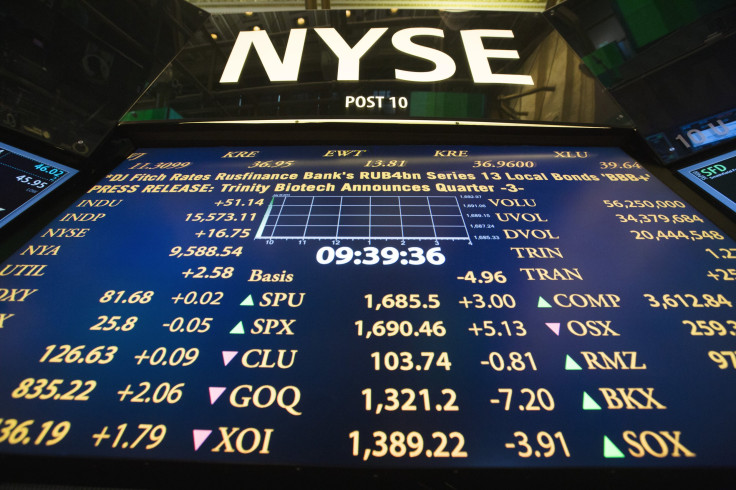US Stock Futures Point To Lower Open Ahead Of Retails Sales Data, PPI, Consumer Sentiment Report, Uncertainty Over Fed's Tapering Decision Next Week

U.S. stock index futures suggest a subdued opening to markets on Friday and ahead of retails sales data, the producer price inflation figures and consumer sentiment report from the U.S.
Futures on the Dow Jones Industrial Average were down 0.12 percent, while futures on the Standard & Poor's 500 Index were down 0.13 percent and those on the Nasdaq 100 Index were up 0.07 percent.
However, most of the attention will be focused on retail sales data for the month of August, which will be published at 8:30 a.m. EDT on Friday. Retail sales data, which is seen as a reliable indictor of the country's economic condition, is expected to influence the U.S. Federal Reserve’s decision on winding down its $85 billion a month asset-buying policy, when the bank's officials meet next week.
Analysts expect that the Fed could announce a nominal trimming of the bond-buying program to convey its confidence in the nation's economic recovery but stop short of a substantial scaling down of the program, given the slightly disappointing unemployment data for August released, last week. The unemployment rate fell to 7.3 percent, its lowest since 2008, but the lesser-than-expected drop was driven by people leaving the workforce rather than by strong job creation.
“The week will be dominated by the US Fed’s policy meeting and whether it will decide on Wednesday to start tapering its $85bn per month asset purchase program. Three-quarters of economists polled by Reuters expect the taper to start this month, despite a weaker than expected employment report for August,” Chris Williamson, an economist with Markit, wrote in a research note.
“Perhaps most likely is a token gesture of a small reduction to the stimulus program, sending a reassuring signal that the economy is recovering and that the tightening of policy will be carefully engineered in line with the economic data flow,” he added.
Retail sales data, which measures consumer spending that accounts for a bulk of the country's economic activity, is expected to post a gain of 0.6 percent in August, up from a 0.2 percent increase in July.
“A leap in auto sales is likely to have been the main factor behind a solid 0.6% m/m increase in retail sales values in August. But underlying sales growth may have been fairly healthy too. We think auto sales alone could boost overall retail sales by 0.5 percentage points,” Paul Dales, an economist with Capital Economics, wrote in a research note.
Investors are also likely to watch the Department of Labor's Producer Price Index, or PPI -- the leading indicator of consumer price inflation -- for August to be published at 8:30 a.m. EDT. The PPI, which measures the change in the price of goods sold by manufacturers, is estimated to drop 0.1 percent in August after posting a flat reading in the previous month.
The Core PPI for July also released by the Department of Labor on Wednesday, which measures the change in the selling price of goods and services sold by producers, excluding food and energy, is likely to remain steady at 0.1 percent.
“Energy price effects are likely to have weighed on overall producer prices again. Meanwhile, another subdued rise of 0.1% m/m in core prices wouldn’t be enough to prevent overall prices from falling by 0.1% m/m,” Dales wrote in the note.
The consumer sentiment report from Thomson Reuters/University of Michigan, which is due to be released at 9:55 a.m. EDT and shows what consumers in the U.S. think of the nation's business climate and economic conditions, is expected to decline marginally to 82 in the month, from 82.1 reading in the previous month, according to a Bloomberg report.
In Europe, markets traded lower on Friday, ahead of U.S. retail data, and after data released by Eurostat showed that employment in the 17-member euro zone dropped 0.1 percent in the second quarter of 2013 over the previous quarter, but held steady in the 27-nation European Union, or EU. On an annual basis, employment dropped by 1 percent in the euro zone in the second quarter while in the EU employment fell by 0.4 percent compared to a decline of 0.5 percent in the first quarter of 2013.
The Stoxx Europe 600 index was trading down 0.19 percent, London’s FTSE 100 was down 0.27 percent, Germany's DAX-30 was down 0.13 percent and France's CAC-40 was trading down 0.15 percent.
Sweden’s economy contracted 0.2 percent in the second quarter of 2013 compared to the first quarter, more than an initial estimate of a drop of 0.1 percent, mainly due to a decline in investments and exports.
In Asia, most markets traded lower, with the Shanghai Composite index ending down 0.86 percent while Hong Kong’s Hang Seng Index lost 0.17 percent.
Australia’s S&P/ASX 200 ended down 0.44 percent, South Korea’s KOSPI Composite index declined 0.49 percent, while, Japan’s Nikkei ended up 0.12 percent. India’s BSE Sensex ended down 0.25 percent.
© Copyright IBTimes 2024. All rights reserved.






















